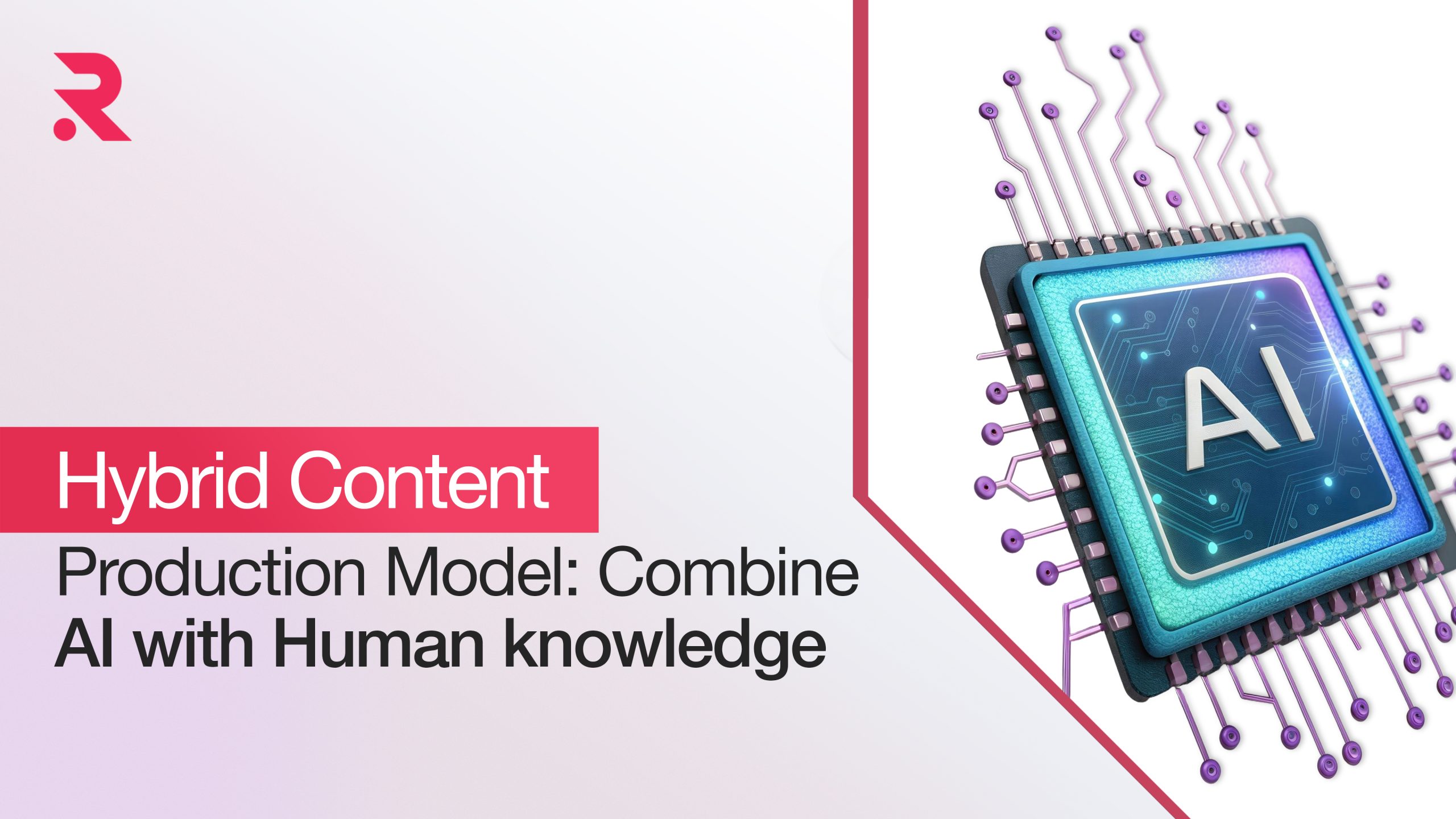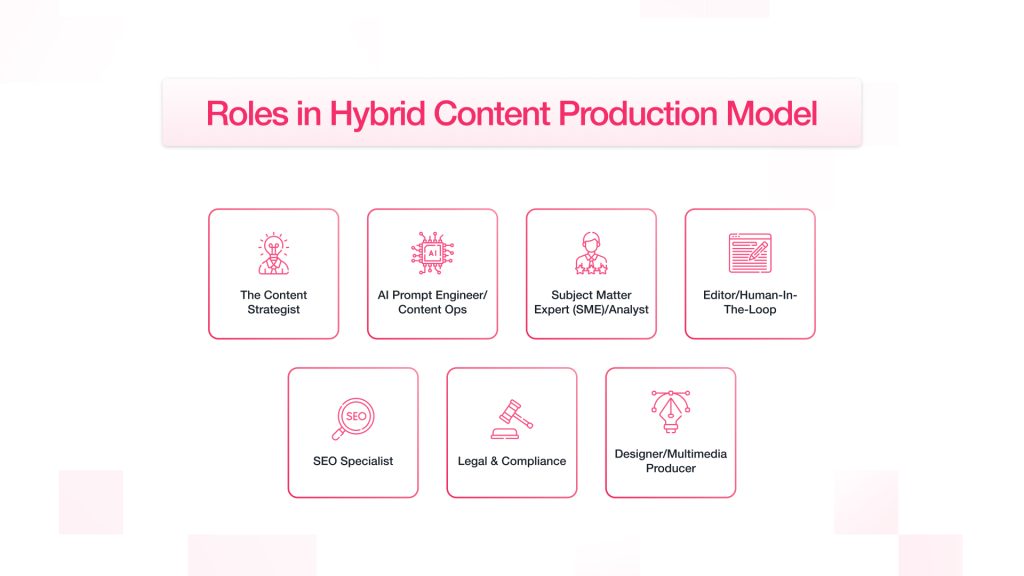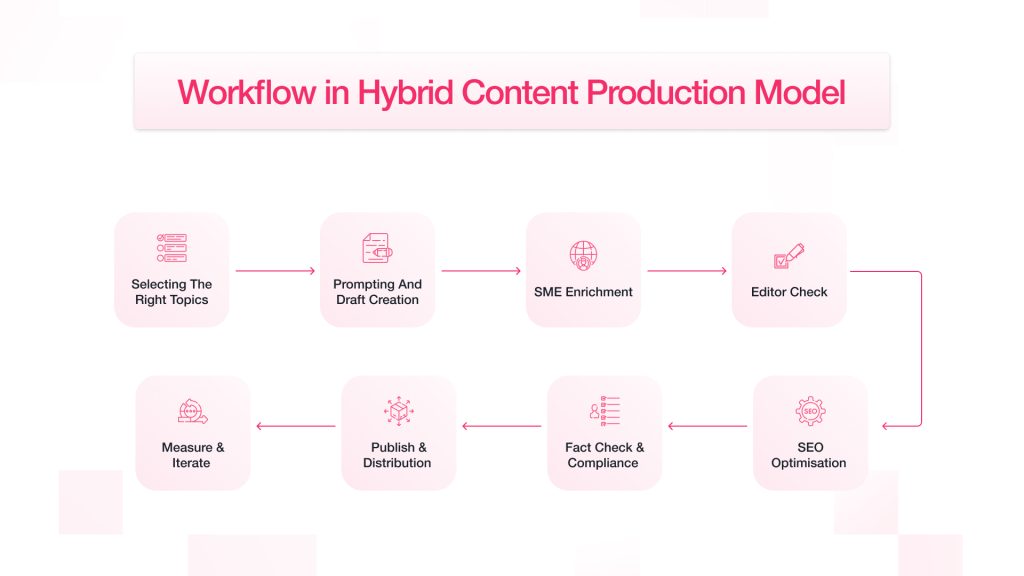AI + Human: Building a Hybrid Content Production Model that Works
Develop a hybrid content production model that merges AI’s speed with human wisdom. Your team will get brand-focused, true, and SEO-ready content fast and on a big scale. There are easy steps that you can follow. Rules and checklists exist for marketers who look for good and fast work! Simultaneously, that will help to build faith in anything you may want to see or share.
- August 28, 2025
- by Tarun


The case for a hybrid model — blunt and honest
AI can help create drafts and outline ideas. It can also sum up research and help you change content for each person. A lot of people in marketing now use AI to help with key tasks. New data shows that the main reasons they use AI are for making content, doing research, and finding new ideas.
But human skills still matter a lot. You have to have people who know how to pick and lead a group. They use their own life experience and know a lot about the topic. These people also give the brand its own style. The work has to be clear and always honest. The feeling people get from the content also comes from these skills.
HubSpot and other reports say that more people are now using AI in the content industry. Still, most do not totally trust AI content on its own. It needs people to check its work.
Introduction
AI Tools are no longer new. People now use them in their day-to-day work to make content. But just working fast is not enough. The real way to win is to use AI’s speed along with what people know, feel, and imagine. When you put these together, you get a content model that brings people and AI into one plan. This mix helps you to work fast and do things again in the same way. It also helps you be trusted by users and search engines at the same time.
Core principles for a robust Hybrid Content Production Model
Think of this as the plan for your process.
- AI works as an assistant; People are the owners: The AI gives out drafts. It also shares ideas. AI shows what people are searching for. Humans decide what goes live. (This stops “AI slop” and helps keep your brand real.)
- People-first content: Create for your audience first, search engines second — Google’s guidance emphasises helpful, people-first content. Align outputs with that principle.
- E-E-A-T is built in: You need to show that there is real experience, know what you are talking about, be a person or brand people trust, and make sure others see you as a trusted source. Use quotes from experts or share what they say. Also, show how you checked if the facts are true.
- Iterative testing and measurement: Try A/B tests, look at the SERP results, and check your engagement numbers. This can help you know what works best for your group.
- Responsible governance: We need people in charge who do the right thing. Keep a record of the prompts, datasets, and all choices that the editors make. Be sure you have full rights to copyright. Get consent for everything you do, and always make sure things are fair for everyone.
Team roles and who does what (practical)
A hybrid model works well when everyone knows their job. Here’s a common setup that many mid-size marketing teams use.

- The Content Strategist (owner): Picks the main topics for the content and also sets the goals that the team needs to reach. This person makes a plan for where the content will be shared. They also figure out how to check if their work is bringing good results. The Content Strategist looks at how well the work is doing and then chooses which topics should get attention first.
- AI Prompt Engineer/Content Ops: The AI Prompt Engineer makes prompts, keeps up the prompt library, and uses AI tools to create first drafts. The role also handles groups of tasks at once.
- Subject Matter Expert (SME)/Analyst: Checks that all facts in the content are correct, gives sources, shares new ideas, and confirms that the technical or YMYL content is good.
- Editor/Human-in-the-Loop: Sets the tone, keeps to the rules, checks facts, and uses SEO.
- SEO Specialist: Handles keyword mapping, schema, the plan for linking pages inside the site, and checks how well things are working.
- Legal & Compliance: Looks over content that is private or has rules on it.
- Designer/Multimedia Producer: This person takes content and turns it into pictures, video, and short pieces for different channels.
Small teams can have people take on more than one role. The main thing is for people to always be in charge and check things themselves.
Need Technical SEO guidance and support to boost your website rankings?
Our Experts Can Help!
The Hybrid Workflow
Here is a simple way you can use again and again. You can change it to fit your needs.

Start by picking the right topics
You can use keyword tools and intent tools to help you choose. Make an intent brief that shows the main keywords you picked. Add details about the people you want to reach, what you want them to do, and show some strong examples from the search results page.
Prompting and draft creation (Prompt Engineer)
You will use set prompt templates to make outlines, draft copies, metadata, and topic groups. Keep prompts and starting data in a prompt library so the same results can be made again.
SME enrichment (SME)
SMEs share new facts, stories from real work, and fresh ideas from the business. They also use their own knowledge that AI does not have. Be sure to clearly show what has been added.
Editor check
Edit to match the best style and help make things clear. Take out any repeated words or things that seem too simple. Add new ideas and give strong reasons for people to act. This will help get better results.
SEO optimisation (SEO Specialist).
Add internal links, so people can easily go from one page to another on the site. Set up schema, meta tags, and headings. Use alt text for images. Add helpful signals on each page. This can help get better search results. Run a tool like Surfer, Clearscope, or one like them to make sure you cover the topic well.
Check facts and follow all rules (SME + Legal)
Make sure to look over all claims, numbers, and permissions. Keep a log to show what you have checked for high-risk content.
Publish & distribution (Content Ops)
You can publish, plan, and share your content on many channels. Be sure to check all numbers, claims, and permissions. Take time to look at the details.
Track and test (Analyst)
Watch things like CTR, how long people stay, conversions, and where you show up in organic searches. Try new things and update the content every few months.
Tools and Tech stack — what helps, what to avoid
Use tools that help make things go smoother. Do not use ones that take away your judgement.
- Research & SEO: Semrush, Ahrefs, Google Search Console, and Surfer or Clearscope help you find the right words to use. They also help you cover important topics.
- AI draft & suggestion tools: Large language models can be used to make drafts. These tools can also help you by giving summaries. They give you different ways to write what you want. You can pick enterprise versions, and some of these keep your privacy safe. This is important when you work with data that must be kept private. The tool you pick should be based on your need for privacy, how good the AI model is, and the way the API is managed.
- Content ops and workflow: Use Trello, Asana, or Notion to help with workflows. Also, use digital asset management for images.
- Plagiarism & detection: Make use of checks for copied work and look over things yourself. AI may, without knowing it, say things it gets from its training.
- Prompt management: Means having a shared prompt library. This library shows different versions, notes for context, and results from each prompt. The library helps people in the team learn from one another and keep all important knowledge in one place.
Watch out for vendor lock-in, models that use public data that is not checked, or tools that say they will do “fully automated publishing” with no person checking the work. These things can put you at risk.
E-E-A-T and Quality Control
Google is putting people and helpful content first. The E-E-A-T idea also matters a lot. Because of this, teams that have different types of people working together need to be clear about where the work comes from and show their skills.
Concrete steps:
- Bylines and author bios. Include the author’s background, work history, and how you can reach them to check that this is real. This shows that the person has a lot of knowledge and has worked on this before.
- Citations & sources. When you say something, be sure to give a link to the main sources or use the data from inside your team. Say if AI has helped write any of it, if that matches the topic.
- SME approval. For YMYL or technical topics, you should get SME approval before you put it out.
- Editorial checklist. Make a checklist to use before you post anything. Check that the facts are right, the images can be used, look for any bias, and add good references. Make sure to add schema, metadata, and a call to action.
- Transparency statement. If AI helped in a big way, add a clear note about it. This helps people trust the content and can help lower problems with rules or policy. Google has, for a long time, explained how AI content fits into its ways of working. Being open and useful is still very important.
SEO specifics: how to keep your hybrid model search-friendly
Write for people and structure for search.
- Map each page to one main search intent. Start with what people are looking for, not just keywords. Let AI help make different versions of the page. After that, have people check and edit the content. This will make sure the writing fits the main intent. Add real examples, case studies, and your own data to make it better.
- You should focus on making the content clear and complete, not just filling it with keywords. Use tools to find other words and questions, but you should have people write answers that sound natural.
- Structured data & metadata. Always use schema (Article, FAQ, HowTo, Product) and write meta titles and descriptions that stand out from the rest.
- Staying up to date is important. Hybrid models can help you update faster. You can choose how often you update — every few months or even more often, if the topic changes quickly. This way, you always have the facts right and can add new expert ideas when needed.
- Do not make low-effort AI content. Google’s helpful content systems can lower the rank of content that looks like it is just made for search when it does not offer real value. Add your own views and put in human knowledge.
Need help with generating website Traffic with AI SEO?
Our Experts Can Help!
Measurement
Don’t think that looking good is the same as a real win. Be sure to keep an eye on how things work and how well to use them.
Primary KPIs:
- You will see more visits and better ranks on the target keywords with good SEO.
- The number of people who finish the call to action on pages made with hybrid workflows.
- Time to publish and cost for each piece (better use of time and money).
- Engagement numbers show us things like how long people stay on the page, how far they scroll, and how often they share it on social sites. These things help us know something about the quality of the content.
- Accuracy and error rate show how often facts have to be checked or changed.
- Reuse rate is about how often people get AI drafts and turn them into final content with just a little editing.
Important: run controlled experiments. For example, you can try out the hybrid process with some topics. Then compare how well these do against topics with only human or only AI drafts over 90 days. Some people in the industry say mixing human and AI gives bigger gains in getting people to act and helps work faster than using just old methods. But you need to test this in your own setting to see what you get.
Conclusion
A Hybrid Content Production Model is not just a one-time thing. It is a big change in how you work. You should think of AI as something that helps human choices, not something that takes their place. Make clear rules, share your work in an open way, and keep trying new things quickly. When you let people decide the meaning, context, and what is right, you get both the help of AI and the trust that only people can give. This way, you get strong SEO results that last.
 Shopify
Shopify

















